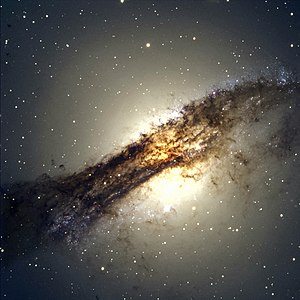Centaurus A (also known as NGC 5128) is a prominent galaxy in the constellation of Centaurus. There is considerable debate in the literature regarding the galaxy's fundamental properties such as its Hubble type (lenticular galaxy or a giant elliptical galaxy) and distance (10-16 million light-years). NGC 5128 is one of the closest radio galaxies to Earth, so its active galactic nucleus has been extensively studied by professional astronomers. The galaxy is also the fifth brightest in the sky, making it an ideal amateur astronomy target, although the galaxy is only visible from low northern latitudes and the southern hemisphere.
A relativistic jet which extracts energy from the vicinity of what is believed to be a supermassive black hole at the center of the galaxy is responsible for emissions in the X-ray and radio wavelengths. By taking radio observations of the jet separated by a decade, astronomers have determined that the inner parts of the jet are moving at about one half of the speed of light. X-rays are produced farther out as the jet collides with surrounding gases resulting in the creation of highly energetic particles. The radio jets of Centaurus A are over a million light years long.
As observed in other starburst galaxies, a collision is responsible for the intense burst of star formation. Using the Spitzer Space Telescope astronomers confirm that Centaurus A is going through a galaxy collision by devouring a spiral galaxy.

| Centaurus A (NGC 5128) | |
| Observation data (J2000 epoch) | |
|---|---|
| Constellation | Centaurus |
| Right ascension | 13h 25m 27.6s |
| Declination | -43° 01′ 09″ |
| Redshift | 547 ± 5 km/s |
| Distance | 10-16 Mly (3-5 Mpc) |
| Type | S0 pec or Ep |
| Apparent dimensions (V) | 25′.7 × 20′.0 |
| Apparent magnitude (V) | 6.84 |
| Notable features | Unusual dust lane |
| Other designations | |
| NGC 5128, Arp 153, PGC 46957, 4U 1322-42 | |
Centaurus A may be described as having a peculiar morphology. As seen from Earth, the galaxy looks like a lenticular or elliptical galaxywith a superimposed dust lane. The peculiarity of this galaxy was first identified in 1847 by John Herschel, and the galaxy was included in the Atlas of Peculiar Galaxies (published in 1966) as one of the best examples of a "disturbed" galaxy with dust absorption. The galaxy's strange morphology is generally recognized as the result of a merger between two smaller galaxies.
The bulge of this galaxy is composed mainly of evolved red stars. The dusty disk, however, has been the site of more recent star formation; over 100 star formation regions have been identified in the disk.
Distance
Distance estimates to NGC 5128 established since the 1980s typically range between 3-5 Mpc. Classical Cepheids discovered in the heavily-obscured dust lane of NGC 5128 yield a distance between ~3-3.5 Mpc, depending on the nature of the extinction law adopted and other considerations. Mira variables and Type II Cepheids were also discovered in NGC 5128, the latter being rarely detected beyond local group. The distance to NGC 5128 established from several indicators such as Mira variables and planetary nebulae favour a more distant value of ~3.8 Mpc.
source : www.wikipedia.com
No comments:
Post a Comment